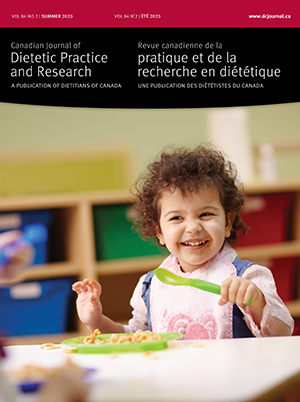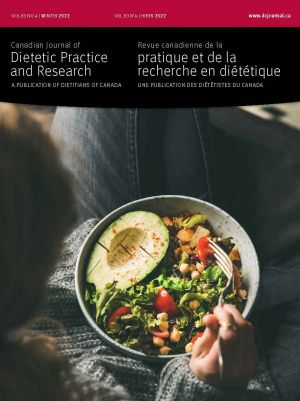Volume 76 • Number 4 • December 2015
Chair's Message
Editor's Message
Original Research
Purpose: To examine lunch sources during the school week among students and the associations with fruits and vegetable (F&V) and sugar-sweetened beverage (SSB) consumption. Methods: Students (n = 23 680) from 43 Ontario, Canada, secondary schools completed a health behaviour survey in the Year 1 COMPASS study. Analysis used generalized linear mixed effects models. Results: The most frequently reported lunch source was home (2.9 days per school week), then the school cafeteria (1.1) and fast-food places or restaurants (FFRs) (0.9). Eating a home lunch was associated with having less spending money, white ethnicity, and females; whereas cafeteria lunch was associated with more spending money, lower school grade, and females. A FFR lunch was associated with males, more spending money, and higher physical activity. Greater frequency of a home lunch was associated with greater F&V consumption. Greater frequency of a FFR lunch was associated with more frequent SSB consumption. Cafeteria lunches were associated with increases in both SSB and F&V. Conclusions: Eating a lunch obtained from outside of the home is a regular behaviour among students. Sources of school-week lunches may have an important influence on dietary intake among youth. These findings reinforce the need for strategies to promote healthier lunch sources and healthier food options.
Review
In Canada 95% of dietitians are female despite serving a sex-diverse population. Literature examining why there are so few male dietitians is limited. However, nursing, like dietetics, is female dominated but has a large body of literature examining sex diversity within the profession. Therefore, a narrative literature review was conducted to find articles that examined the following questions: (i) What are the barriers and motivating factors for prospective male nursing students? and (ii) What are the perceived sex-based challenges that male nursing students encounter during their education? A total of 38 articles were included in the final review and the results are presented under the following headings: barriers, motivators, and educational experiences both in the classroom and during clinical rotations. The review outlines the current state of knowledge regarding sex as it relates to nursing and how this information compares with the current dietetics literature. Conclusions and recommendations are drawn about what changes could be made in dietetic education immediately and how further research could provide insight towards reducing the barriers and facilitating easier access to dietetics education for males.
Perspectives in Practice
Many Canadian school jurisdictions have developed nutrition policies to promote health and improve the nutritional status of children, but research is needed to clarify adherence, guide practice-related decisions, and move policy action forward. The purpose of this research was to evaluate policy adherence with a review of online lunch menus of elementary schools in Nova Scotia (NS) while also providing transferable evidence for other jurisdictions. School menus in NS were scanned and a list of commonly offered items were categorized, according to minimum, moderate, or maximum nutrition categories in the NS policy. The results of the menu review showed variability in policy adherence that depended on food preparation practices by schools. Although further research is needed to clarify preparation practices, the previously reported challenges of healthy food preparations (e.g., cost, social norms) suggest that many schools in NS are likely not able to use these healthy preparations, signifying potential noncompliance to the policy. Leadership and partnerships are needed among researchers, policy makers, and nutrition practitioners to address the complexity of issues related to food marketing and social norms that influence school food environments to inspire a culture where healthy and nutritious food is available and accessible to children.
The purpose of this study was to provide preliminary Canadian research assessing nutrition students’ cultural competence and to identify areas for future education initiatives in dietetic education that could ultimately improve dietitians’ cultural competence. A mixed-methods study was conducted using a 24-item questionnaire that was administered to students enrolled in third- and fourth-year undergraduate nutrition classes (n = 133). In total, 115 questionnaires were analyzed for quantitative data, and 109 were analyzed for qualitative data. The students scored an overall medium–high level of cultural competence. Out of the 5 areas examined (skills, attitudes, awareness, desires, knowledge), students’ multicultural knowledge scores were the lowest. It was found that a lower number of barriers to learning about other cultures were significantly associated with a higher overall cultural competence score, and taking a course in cultural foods significantly increased the students’ knowledge and overall cultural competence (P ≤ 0.05). The qualitative data found that students felt the cultural competence curriculum had gaps and identified several ideas for improvement. In conclusion, this research data provides novel insights into the cultural competence of Canadian dietetic students and additionally supports future research and curriculum development to enhance cultural competence.
The Professional Development Network (PDN) program was implemented to enhance mentoring and learning opportunities for dietitians at a multisite health care organization. Program development, implementation, and evaluation were carried out by a Professional Practice Council composed of dietitians in the organization. An exploratory evaluation was conducted after the first year of PDN implementation. Evaluation data were collected from an online survey containing open- and closed-ended questions and PDN documents submitted by dietitians. Data were analyzed with descriptive statistics and thematic analysis. Survey results indicate the PDN provided a mechanism for dietitians to learn from each other, apply learning to their career development, reflect on their strengths, and connect with others in the department. Analysis of PDN documents showed that dietitians pursued learning related to clinical practice, technology, private practice, and research. Mentoring interactions were also described by participants within PDN documents. Findings from this study demonstrate how multiple frameworks from academic literature can be integrated to create a professional development program in a dietetics practice environment. Evaluation results from this study may provide useful insights for others interested in implementing professional development programming.
Clinical acumen is often used to assess families’ motivation prior to initiating pediatric obesity management due to a lack of available tools. The purpose of this pilot study was to (i) develop and (ii) pilot test the “Readiness and Motivation Interview for Families” (RMI-Family) in pediatric weight management. We conducted 5 focus groups with parents (n = 15), youth with obesity (n = 11), and health care providers (n = 8) to explore perceptions of barriers to making healthy behaviour changes, which led to the creation of the RMI-Family as a semi-structured interview. Five domains (treat foods, overeating, emotional eating, total physical activity, and screen time) emerged from the focus groups to inform the development of the RMI-Family, which was then pilot tested with a sample of youth with obesity and their parents (n = 11 dyads). Interviewers administered the RMI-Family to youth (age 12.8 ± 1.7 years; body mass index [BMI] z-score: 2.71 ± 0.43) and parents (age 47.1 ± 3.7 years; BMI: 33.5 ± 10.1 kg/m2). The RMI-Family was feasible to administer, easily understood by families, and may be a useful tool for assessing families’ motivation. Research is underway to determine the psychometric properties and utility of the RMI-Family in predicting clinical outcomes in pediatric weight management.
Brief nutrition screening tools are desired for research and practice. Seniors in the Community: Risk Evaluation for Eating and Nutrition (SCREEN-II, 14 items) and the abbreviated version SCREEN-II-AB (8 items) are valid and reliable nutrition screening tools for older adults. This exploratory study used a retrospective cross-sectional design to determine the construct validity of a subset of 3 items (weight loss, appetite, and swallowing difficulty) currently on the SCREEN-II and SCREEN-II-AB tools. Secondary data on community-dwelling senior males (n = 522, mean ± SD age = 86.7 ± 3.0 years) in the Manitoba Follow-up Study (MFUS) study were available for analysis. Participants completed the mailed MFUS Nutrition Survey that included SCREEN-II items and questions pertaining to self-rated health, diet healthiness, and rating of the importance of nutrition towards successful aging as the constructs for comparison. Self-perceived health status (F = 14.7, P < 0.001), diet healthiness (ρ = 0.17, P = 0.002) and the rating of nutrition's importance to aging (ρ = 0.10, P = 0.03) were correlated with the 3-item score. Inferences were consistent with associations between these construct variables and the full SCREEN-II. Three items from SCREEN-II and SCREEN-II-AB demonstrate initial construct validity with self-perceived health status and diet healthiness ratings by older males; further exploration for criterion and predictive validity in more diverse samples is needed.
Report
Purpose: To describe the food security status, food insecurity coping strategies, characteristics, and experiences of student clients of the Campus Food Bank (CFB) at the University of Alberta in Edmonton, Alberta, Canada. Methods: A convenience sample of 58 students completed a survey from April 2013 to April 2014. Food security status was determined using the “Adult Food Security Survey Module”. Results: Ninety percent of CFB student clients who participated in this study were food insecure, which included both moderately and severely food insecure groups. The most prevalent coping strategies for food insecurity included applying for a loan or bursary (86.2%), seeking employment or working more hours (84.5%), and purchasing food using a credit card (77.6%). Participants were a diverse mix of students, including graduate students (50.0%), international students (46.6%), and caregivers of children (24.1%). The most common primary sources of income were government student loans (29.3%) and research assistantships (20.7%). Most participants (82.8%) liked the food they received from the food bank. Conclusions: Food insecurity is highly prevalent among student clients of this university-based food bank. Students used a variety of coping strategies to increase their disposable income, highlighting the need for additional strategies to alleviate food insecurity among vulnerable students.
Purpose: Canada’s Food Guide (CFG) defines food serving sizes and recommends a specific number of servings from each of the 4 food groups. However, there is no differentiation in serving sizes for different versions of foods that may differ in nutritional value. Methods: Participants (n = 20) estimated serving sizes of “healthier” and “unhealthier” versions of milk, bread, cereal, potatoes, chicken, fish, and juice and reported the amount normally consumed in 1 sitting. Results: Participants estimated unhealthier servings of cereal and juice to be smaller than healthier servings, but estimated unhealthier servings of chicken to be larger than healthier versions (P < 0.05). There were no differences for bread, milk, potatoes, and fish. Accordingly, estimated servings of juice (P < 0.01) had more calories than the unhealthier orange drink. There were no caloric differences for cereal (P = 0.12), but an estimated serving of bran flakes had more fat and fibre than frosted flakes cereal. Conclusions: In contrast with CFG, which does not account for different versions of food, certain unhealthier foods were estimated to be smaller or larger than the healthier versions. However, both healthy and unhealthy serving sizes still tended to be larger than what is prescribed in CFG. Thus, better education or revision of serving sizes in future editions of CFG may warrant consideration.










